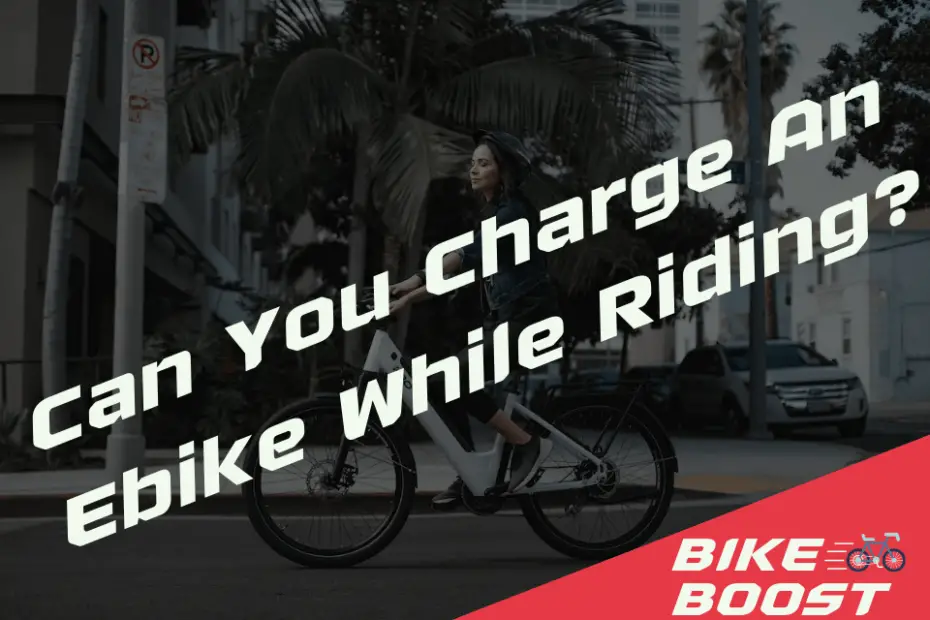We love writing these guides for you and sometimes we are compensated when you use one of our links to buy a product. This doesn’t impact the final price you pay. If you want to learn more about how this works, please see our Affiliate Disclosure page.
Introduction
As the popularity of electric bikes (e-bikes) continues to rise, many riders are curious about the charging process. One common question that arises is whether it is possible to charge an e-bike while riding. In this article, we will explore this topic in detail and provide insights into the feasibility, considerations, and benefits of charging your e-bike while on the go.
Understanding E-bike Batteries
To grasp the concept of charging an e-bike while riding, it’s essential to have a basic understanding of e-bike batteries. Most e-bikes are powered by lithium-ion batteries, which offer high energy density and long-lasting performance. These batteries store the electrical energy needed to power the electric motor and assist the rider.
Charging an E-bike: The Basics
Typically, e-bike batteries are charged by plugging them into a power source using an adapter. The charging process involves transferring electrical energy to the battery cells, replenishing their charge. E-bike manufacturers usually provide specific instructions on how to charge their batteries, including recommended charging times and precautions.
Can You Charge an E-bike While Riding?
The concept of charging an e-bike while riding, also known as regenerative braking or regen mode, is gaining attention. Regen mode allows the electric motor to act as a generator, converting the kinetic energy produced while riding into electrical energy to recharge the battery. However, it’s important to note that not all e-bikes support regen mode, and the efficiency of regenerative charging can vary.
While regenerative braking sounds like an innovative solution, the reality is that it currently has limitations. The amount of energy generated through regen mode is relatively small compared to the overall energy consumption of the e-bike. Therefore, relying solely on regen mode to charge your e-bike while riding may not provide a significant boost to the battery’s charge.
Factors to Consider
Several factors influence the feasibility of charging an e-bike while riding:
- E-bike Model and Features: Some e-bike models are equipped with regenerative braking capabilities, making them suitable for charging while riding. However, it’s crucial to check the manufacturer’s specifications to determine if your e-bike supports this feature.
- Riding Conditions: Regenerative charging works best when riding downhill or during braking. The energy generated from these situations can contribute to recharging the battery. However, on flat terrain or during continuous pedaling, regen mode may have limited effectiveness.
- Battery Capacity: The size and capacity of your e-bike battery play a significant role in the feasibility of charging while riding. Higher-capacity batteries may offer better regenerative charging potential.
- Riding Style and Terrain: Aggressive riding styles that involve frequent braking or riding in hilly areas can provide more opportunities for regenerative charging. On the other hand, casual riding on flat surfaces may not yield substantial energy regeneration.
Benefits and Drawbacks
Charging an e-bike while riding presents both benefits and drawbacks worth considering.
Benefits:
- Extended Range: Regenerative charging can provide a slight increase in range by harnessing the kinetic energy produced during riding.
- Energy Efficiency: Utilizing regen mode reduces energy wastage and promotes eco-friendly transportation.
- Convenience: In certain scenarios, regenerative charging can eliminate the need for frequent stops to charge the battery.
Drawbacks:
- Limited Charge Contribution: The amount of energy generated through regen mode is typically minimal compared to the overall energy consumption of the e-bike.
- Battery Health and Longevity: Frequent use of regenerative charging may slightly increase the wear on the battery cells over time.
- Dependency on Riding Conditions: Regenerative charging efficiency varies depending on the riding style, terrain, and other factors. It may not be a reliable charging method in all situations.
Safety Precautions
If your e-bike supports regenerative charging, it’s essential to follow some safety precautions:
- Read the Manufacturer’s Guidelines: Familiarize yourself with the manufacturer’s recommendations regarding regen mode usage and charging procedures.
- Monitor Battery Temperature: Extended regenerative charging may lead to increased battery temperature. Keep an eye on the battery’s temperature and avoid overheating.
- Balance Regen and Mechanical Braking: Depending solely on regen mode for braking can put excessive strain on the battery and braking system. Maintain a balance between regen braking and traditional mechanical braking.
- Be Mindful of Road Conditions: Regen mode may impact the e-bike’s braking performance. Adjust your riding style and be cautious of potential hazards on the road.
Charging Options for E-bikes
While regenerative charging offers a way to replenish your e-bike’s battery while riding, it’s important to note that it may not be the most efficient method. For optimal charging, it is recommended to connect your e-bike to a power source using the provided charging adapter when it’s not in use. This allows for a full charge and ensures the battery’s longevity.
Conclusion
While the concept of charging an e-bike while riding through regenerative braking is intriguing, its practicality is limited. Regen mode can contribute a small amount of energy to recharge the battery, but it should not be solely relied upon for charging. Optimal charging is achieved by connecting the e-bike to a power source using the provided adapter. By understanding the factors involved, you can make informed decisions about charging your e-bike and enjoy its benefits to the fullest.
FAQs
Can I convert my mountain bike to electric?
Yes, it is possible to convert a mountain bike into an electric bike. By adding an electric motor kit, you can transform your regular bike into an e-bike. Check out our comprehensive guide on converting a mountain bike to electric for more details.
Can I turn my bike into an e-bike?
Certainly! Converting a regular bike into an e-bike is a popular option among cycling enthusiasts. Find out more about the conversion process in our dedicated article: Can I Turn My Bike into an Electric Bike?
Can I turn my regular bike into an electric bike?
Absolutely! Converting a regular bike into an electric bike is an exciting project. Learn more about the process and requirements in our informative guide: Can I Turn My Regular Bike into an Electric Bike?
Can you add an electric motor to a bicycle?
Yes, you can add an electric motor to a bicycle through a conversion kit. Explore our detailed guide on adding an electric motor to a bicycle to understand the process and available options.
How to convert a cruiser bike to electric?
Converting a cruiser bike to an electric bike is a fantastic way to enhance your riding experience. Check out our step-by-step guide on converting a cruiser bike to electric for all the necessary information.
Where can I get my bike converted to electric?
If you’re looking for professional assistance with converting your bike to electric, there are several options available. Explore our article on where to get your bike converted to electric to find suitable service providers.
Andy is an avid cyclist who enjoys nothing more than a ride out in the hills. Competing in track, road, time trial and mountain bike events in the past, he prefers slower rides out with his family these days.

